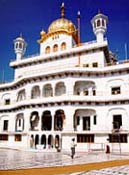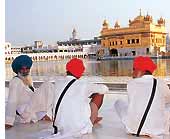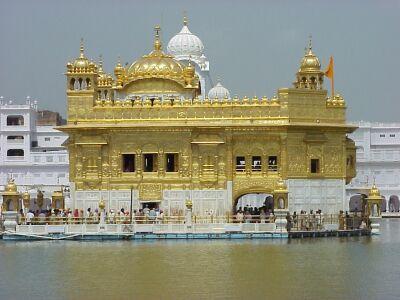Sri Harmandir Sahib
Sri Harmandir Sahib, also know as the Golden Temple in
Amritsar is the
holiest shrine of the Sikh religion.
Also known as the Shri Darbar Shaib, it is in the center of the old part
of Amritsar. The Golden Temple sits on a rectangular platform,
surrounded by a pool of water called the Amrit Sarovar from which the
City is
named. Click here for the
Golden
Temple History.
The entrance to the Golden Temple complex is
through
an ornate archway with intricate inlay work. Verses from the Granth
Sahib are inscribed on the doorway. The
main north entrance is under a Victorian clock tower. Known as the
Darshani
Deori, the entrance is up a flight of steps and down again to the temple
and
holy tank. The temple is a two storey marble structure reached by a
causeway known as Guru´s Bridge. The
lower storey is in white marble with the walls decorated with inlaid
flower and animal motifs in the pietradura style of the Taj Mahal.
The architecture of the golden temple is a blend of the Hindu and Muslim
styles.
 The
upper storey is gold plated, crowned with a dome (the Golden Dome)
shaped
like an inverted lotus. With the first light of dawn, the reflection of
the
temple in the tank gives an ethereal atmosphere to the complex. As the
sun
shifts, the temple presents myriad views, each magnificent and
captivating. The Golden Dome (said to be glided with 100 kg of pure
gold) is supposed to represent an inverted lotus flower,
pointing back to earth to symbolize the Sikh´s concern with the problems
of this world.
The
upper storey is gold plated, crowned with a dome (the Golden Dome)
shaped
like an inverted lotus. With the first light of dawn, the reflection of
the
temple in the tank gives an ethereal atmosphere to the complex. As the
sun
shifts, the temple presents myriad views, each magnificent and
captivating. The Golden Dome (said to be glided with 100 kg of pure
gold) is supposed to represent an inverted lotus flower,
pointing back to earth to symbolize the Sikh´s concern with the problems
of this world.
The temple building has four entrances
instead of the usual single entry. This is symbolic of the openness of
Sikhism and indicates that followers of all faiths are allowed inside.
The walls within are decorated with carved wooden panels and elaborate
inlay work in silver and gold. The Adi Granth, compiled by Guru Arjan
Dev, rests on a throne beneath a jewel-encrusted canopy. Priests conduct
continuous recitation of verses from the holy book in 3-hour shifts. A
complete reading of the text stakes 48 hours. The original copy of the
Guru Granth Sahib is kept under pink shroud in the, Golden Temple during
the day and at around 10 p.m. each day is ceremoniously returned to the
Akal Takht (Sikh Parliament) building. The morning processional
ceremony takes place at 4 a.m. in Summer and at 5 a.m. in Winter, when
Sri Guru Granth Sahib is bought from Akal takhat Sahib in a procession
to the Sanctum Sanctorum, which is washed with milk.

The Akal Takht, next to the Golden Temple,
is the seat of the Shiromani Gurudwara Prabandhak Committee, the
religious governing body of the Sikhs. The building of the Akal Takht
was begun by Guru Arjan Dev and completed in 1609 by Guru Hargobind.
If you miss the early morning or evening processions, the palanquin that
bears the Adi Granth can be seen in the treasury room on the first
floor of the Akal Takht. The palanquin is set with precious stones and
has silver poles and a gold canopy.
Shrines on the northern edge of the corridor
are venerated as the 68 holy shrines of the Hindus. According to the
teachings of Guru Arjan Dev, it was enough for the devout to visit these
shrines and not visit all the original Hindu shrines which are spread
all over the country. Many of these shrines have now been converted into
a martyr’s gallery showing the gruesome history of the Sikhs.
Around
the Parikrama, or pathway, are four rectangular cubicles where Granthis
(priests) sit and recite the Granth Sahib. Pilgrims leave offerings at
the steps, and can also get the holy book recited in their names for a
donation. At the eastern end are two brick watchtowers called the
Ramgarhia Minars, which were damaged during Operation Blue Star in 1984.
The Guru-ka-langar or community canteen is a Sikh institution, which
was started by Guru Amar Das in the 16th century. The practice of eating
together encouraged shedding of inhibitions and the principle of
equality. The community kitchen feeds up to 10,000 people in a day, free
of charges. The food is
normally chapattis and lentils.
The Jubi tree, at the north western corner
of the complex was planted some 450 year ago by the temple’s first head
priest. The old, gnarled tree is believed to have special powers and
childless women tie strips of cloth on it to be blessed with sons.
Marriage deals are also fixed under the tree, though this practice is
disapproved by the temple authorities. Two flag staffs joined in the
middle with the emblem of Guru Hargobind symbolise the dual aspects of
Sikhism – religion and politics. Two swords of the emblem are enclosed
in a circle with the inscription Ek Onkar (God is one). The Guru Ram Das
and Guru Nanak hostels on one side of the complex offer free
accommodation up to three nights for visitors.
The Golden Temple
is open to all.
Pilgrims and visitors to the Golden Temple must remove their shoes and
cover their heads before entering the precincts. No Smoking is allowed
inside the whole temple area, photography is permitted only in/from the
Prakarma , the marble pathway that surrounds the sacred pool. An English
speaking guide is available at the information office near clock Tower
that marks the temples main entrance. The information office has a
number of interesting free publications.
 The
old city, with the Golden Temple and surrounding bazaars along narrow
alleys, is encircled by a ring road. Even today, the markets have an
ambience of ancient times, when traders bought and sold goods right
across from central Asia up to the farthest corners of India. Little
light reaches down to the congested streets, which are best negotiated
on foot. There are rows upon rows of shops on each street selling
specifics goods. Guru Bazaar specialises in gold jewellery shops, while
the Bazaar Kesarian is for steel and brass utensils. The smells of Katra
Kathian announce its wares before you reach the shops selling papads,
warian (crispies made from pulses) murabbas (Indian jams), pickles and
ampapad (dried mango candies). The Mishri Bazaar is the place to buy dry
fruits, while Katra Mohan Singh offers a colourful kaleidoscope of
bridal glass bangles.
The
old city, with the Golden Temple and surrounding bazaars along narrow
alleys, is encircled by a ring road. Even today, the markets have an
ambience of ancient times, when traders bought and sold goods right
across from central Asia up to the farthest corners of India. Little
light reaches down to the congested streets, which are best negotiated
on foot. There are rows upon rows of shops on each street selling
specifics goods. Guru Bazaar specialises in gold jewellery shops, while
the Bazaar Kesarian is for steel and brass utensils. The smells of Katra
Kathian announce its wares before you reach the shops selling papads,
warian (crispies made from pulses) murabbas (Indian jams), pickles and
ampapad (dried mango candies). The Mishri Bazaar is the place to buy dry
fruits, while Katra Mohan Singh offers a colourful kaleidoscope of
bridal glass bangles.
 The
old city, with the Golden Temple and surrounding bazaars along narrow
alleys, is encircled by a ring road. Even today, the markets have an
ambience of ancient times, when traders bought and sold goods right
across from central Asia up to the farthest corners of India. Little
light reaches down to the congested streets, which are best negotiated
on foot. There are rows upon rows of shops on each street selling
specifics goods. Guru Bazaar specialises in gold jewellery shops, while
the Bazaar Kesarian is for steel and brass utensils. The smells of Katra
Kathian announce its wares before you reach the shops selling papads,
warian (crispies made from pulses) murabbas (Indian jams), pickles and
ampapad (dried mango candies). The Mishri Bazaar is the place to buy dry
fruits, while Katra Mohan Singh offers a colourful kaleidoscope of
bridal glass bangles.
The
old city, with the Golden Temple and surrounding bazaars along narrow
alleys, is encircled by a ring road. Even today, the markets have an
ambience of ancient times, when traders bought and sold goods right
across from central Asia up to the farthest corners of India. Little
light reaches down to the congested streets, which are best negotiated
on foot. There are rows upon rows of shops on each street selling
specifics goods. Guru Bazaar specialises in gold jewellery shops, while
the Bazaar Kesarian is for steel and brass utensils. The smells of Katra
Kathian announce its wares before you reach the shops selling papads,
warian (crispies made from pulses) murabbas (Indian jams), pickles and
ampapad (dried mango candies). The Mishri Bazaar is the place to buy dry
fruits, while Katra Mohan Singh offers a colourful kaleidoscope of
bridal glass bangles.

No comments:
Post a Comment